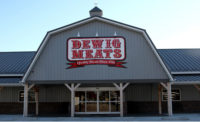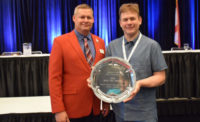Making the best out of breakfast
Williams Sausage’s steady growth is due in part to its popular line of breakfast sandwiches.


















Many successful companies come from humble beginnings, but Williams Sausage may take the top prize in that department. Today, the company has topped $100 million in sales and has enough steady growth to warrant a new expansion about every three years. With its flagship brand name, several regional brands and a thriving private-label business, the company has nationwide distribution for its sausage chubs, links and patties. Its line of breakfast sandwiches has grown so popular that it has greatly expanded its assembly and packaging departments in recent years. All of that success came from one sow.
The company’s founder, Harold Lloyd Williams, had a meat background, working for a local packer after high school and as a meat cutter in the army during the Korean War. After he was discharged, he partnered with a regional processor called Partin Sausage to start a branch in Tennessee. After one year, he bought his partner out and became the owner in 1958. At the onset, it was a custom kill plant with a sausage line on the side. When Williams decided to expand the sausage business, he bought three sows.
“The first thing that happened is that one of them died, which was a big financial blow,” relates Roger Williams, Harold Lloyd’s son and president of the business.
The second sow was processed into a batch of sausage, and he took that sausage and went door-to-door, cold-calling the local grocery stores in the area. Most stores already had a sausage brand for sale, so that first batch was given away as samples.
“In his mind, he still had that one sow left,” Williams says. “He thought, ‘I’ll make a second batch next week and go back to all those grocery stores. If I sell that batch, then I’m in the sausage business. If they don’t buy it, I’m in the custom kill business.’”
The fact that the company’s name today is “Williams Sausage” and not “Williams Processing” should indicate how well he did. That second batch sold out, and Harold Lloyd Williams got into the sausage business.
Williams Sausage got its start in a tin building, built on his wife’s family farm in Union City, Tenn. That building is long gone, replaced by a facility that was at last count 185,000 square feet in size. The most recent expansion was completed in 2011 and expanded the processing area, the cook line and the packaging department. The next expansion is already in the works and will add more packaging lines and 150 jobs.
“We probably add on every three years,” Williams says. “This is the same location; we’ve just renovated and added on constantly over 55 years.”
The Williams family owns approximately 500 acres of land in the area, so finding space to expand is one problem the company does not have.
Breakfast of champions
Williams Sausage ended the custom kill business in 1972 when it became federally inspected. From then on, the focus was on growing the sausage business. The company had at the time, a direct store delivery service with four routes. Now, it has its own line of delivery trucks and tractor trailers and has 39 DSD routes.
Everything that the company makes in its facility is related to sausage. The product line includes raw and fully cooked sausage patties and links, sausage chubs and breakfast sandwiches. The company also offers ham, bacon and smoked sausage, but those products are co-packed.
Williams Sausage’s premium product is its whole-hog, pre-rigor sausage. The time it takes to kill the sow to when the meat is packaged is typically less than 45 minutes. The meat is still quite warm when it’s packaged into chubs – upwards of 90 degrees – so the chubs are quick-chilled using a propylene glycol chiller.
“You’re processing the pork before rigor mortis sets in, so the texture and taste is completely different from something made out of pork trimmings, which is post-rigor,” Williams explains. “Getting it into the package quickly and freezing it quickly locks in all the juices and flavor to the product.”
Whole-hog sausage, as the name indicates, includes using primal cuts like hams, loins and shoulders, making the sausage a very lean product. Williams says that the company battles with not having enough fat in the hog to make a really good sausage.
“They’ve bred hogs to make them leaner, and that carries over to the sows we kill,” he says. “We try to buy animals that are in the 550-pound range in weight, but they’re hard to find.”
Some of Williams Sausage’s growth has come from expanding into new sectors. For instance, it added on foodservice distributors and grocery wholesalers as customers and gained a nice bump in sales from doing so. Since adding on private label business, it has added customers like Kroger, WalMart, Aldi’s and HEB. Its sausage products are now distributed nationwide.
The company has also enjoyed accelerated growth after some successful business decisions. Over the last dozen years, Williams Sausage has acquired two regional processors that became available. In 2001, the company acquired Grogan’s Sausage, a local competitor that previously had acquired the Partin Sausage brand that gave Harold Lloyd Williams his start. The J.C. Potter brand, acquired in 2011, is sold in Oklahoma, Arkansas and Texas. Neither brand has the reach of the Williams flagship brand, but they sell well in their markets.
The company also has, for the last 15 years, brought in pork trimmings to make different grades of fully cooked sausage. The Williams brand remains the premium, whole-hog sausage, but other brands like its Ole South are value brands.
“When we did that, it opened up a whole new market for us,” Williams says. “We still kill sows, but we use more meat from the outside than we do from sows we kill.”
A significant part of the company’s natural growth has come from its breakfast sandwiches. Roger Williams helped the company expand into that market when he joined the company, seeing the success that companies like Jimmy Dean and Tennessee Pride had. The initial product offering of a sausage and biscuit sandwich took off, and the company now has 15 SKUs of breakfast sandwiches under its own brand, as well as private label sandwiches. Sausage, bacon, egg and cheese are among the ingredients served on biscuits and croissants.
The continued growth of the breakfast sandwiches is helping Williams Sausage expand its range. Currently, the Williams brand is sold from Illinois and Indiana down to Alabama and Mississippi.
“Every year, we take on a little more territory and are constantly working on expanding the Williams brand,” Williams says. “For the other smaller brands like Grogans, we leave them in the geographic area where they are strongest.”
The last major expansion for Williams Sausage involved a $20 million investment in the company. The processing area, where the grinding and blending is done, was increased to accommodate the company’s growth. More lines were added to the company’s chub packaging capabilities, and a cook line was added. The company now has two cook lines devoted solely to the production of breakfast sandwiches. The sandwich packaging department was also expanded.
Approximately 150 employees were added as a result of that expansion, bringing the company up to about 415 workers.
With the expansions, Williams Sausage now has five lines devoted to the production of breakfast sandwiches, with two more on the way in the next expansion. That project will not add to the building’s size but will add new employees to the sandwich production department. When the hiring is completed, Williams Sausage will have more than 550 workers, Williams explains.
The sandwiches are a labor-intensive process. At peak production, dozens of employees man each line, adding layer on top of layer as the sandwiches race by on the conveyors. The process moves so quickly that it is almost impossible to keep up with the sausages, egg patties, cheese slices and more are they are stacked on top of the biscuits or croissants en route to being packaged and boxed for shipping. Williams notes that sandwich assembly is not an area that has been improved by technology.
“I don’t think anybody has perfected a machine that could do it, especially with the variety of sandwiches we make,” he says. “You have to handle a pre-cooked bacon slice different than you would a sausage.”
Aside from the sausage patties, all the other ingredients are purchased from outside sources, and the company has had to upgrade its storage capacity to accommodate them. It has steadily improved its infrastructure as the building has grown as well. The addition of spiral freezers to the cook lines required additional refrigeration, and the sewer and water systems also had to be beefed up.
Williams credits the state, county and city governments for supporting the company through all the growth. The Williams Sausage is one of the largest employers in the county, and the company has been given several grants to do the upgrades and train new workers. Despite the fact that Union City does not have any large population centers nearby, Williams says that finding employees has not been a problem for the company.
“There used to be a Goodyear tire plant here in Union City,” he says. “They were the biggest employer and paid the best wages, and we had really low unemployment. They closed two years ago, so our unemployment rate is higher now, and it’s made it easier to find employees.”
Williams Sausage also draws many employees from across the border in Kentucky, where the unemployment rate has traditionally been higher.
Williams Sausage has on average grown by 6 or 7 percent each year, and that steady growth has been deliberate. The company has been debt averse, so it expands only when it can afford to do so. The preference to grow organically also applies to its attitude toward promoting its employees. Williams Sausage has never been big on hiring from the outside, Williams says.
“We like to develop our own people who started at ground level and try to develop them up through the system, from production and sales,” he says. “It takes time to develop those people, but we feel that it’s the right way, because it gives the people who started at a lower level the opportunity to advance and move up the ladder.”
Williams Sausage looks to phase out gestation crates
In order to make its premium whole-hog sausage, Williams Sausage slaughters about 1,600 sows per week. There are few farmers in the immediate vicinity of Union City who raise hogs, so the animals are brought in from North Carolina, Oklahoma, Iowa and Canada.
This January, the company announced that it was calling on its suppliers to discontinue the use of gestation crates within the next 10 years.
“We’re not big enough to sway the whole industry,” Williams says, “but I think what everyone is trying to do is try to make sure the animals we use are treated as humanely as possible.”
It was important to Williams that the announcement would give suppliers enough time to consider all alternatives to gestation crates and come up with the most humane method. A more immediate deadline, he notes, would create a financial burden on small family farmers.
“There are a lot of ideas out there {to replace gestation crates],” he says,” and it takes time to figure out what works for everybody.”
Williams Sausage meets The Possum
Being a sausage processor in Tennessee has its perks. When a country legend like George Jones starts looking for a processor to make sausages using an old family recipe, Williams Sausage got the call.
“He was the first to tell you that he was a singer and not a businessman,” Roger Williams says of the late country music legend.
Williams Sausage got to work with Jones through a local entrepreneur who made barbecue sauces, including one that used Jones’ name. After some talks, they decided to market a brand of George Jones sausage and called on Williams Sausage to do the processing. The company agreed to a licensing deal with Jones and developed a line of breakfast sausages. The brand got off to a hot start due to the novelty of it, and it currently is distributed in Tennessee, Kentucky and Ohio.
Williams made several trips to visit Jones and has an autographed guitar in his office as a remembrance of that relationship. Most of his business dealings were done through Jones’ wife, Nancy, whom Williams calls Jones’ savior.
“She’s really the one that pulled him together and got him to stop drinking, and she was really the businessperson,” Williams says. “Even with our dealings with him, a lot of it was with Nancy. He just loved to sing and could care less about the business.”
Looking for a reprint of this article?
From high-res PDFs to custom plaques, order your copy today!















